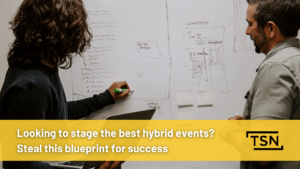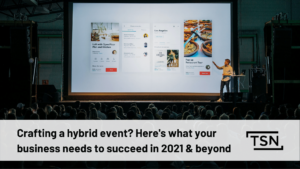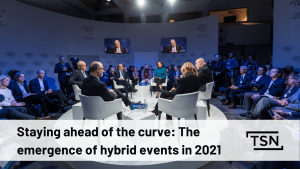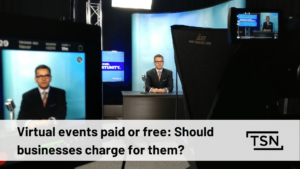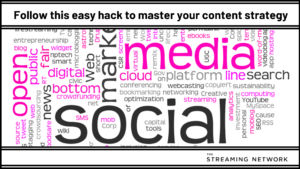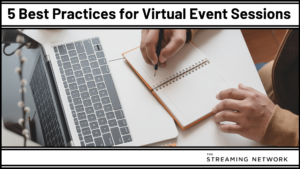Podcast: Play in new window | Download | Embed
Subscribe: Apple Podcasts | Google Podcasts | RSS
Lessons From The Frontline
In our last episode, we discussed some of the challenges faced by marketers producing their webinars in a studio. We also looked at how to take your webinars to the next level and the importance of recording in a studio over your boardroom and some of the common mistakes that may arise whilst planning a webinar.
Previously, we talked about the importance of hybrid events at your next physical conference. Specifically on the ability to gain new audiences and increase your ROI.
This week, Peter and I wanted to examine this webinar marketing tactic further and weigh in on some of the common mistakes marketers can fall prey to and how to avoid them. Keep watching to learn 3 tips on how to host a successful hybrid event.
In our eleventh episode, we are discussing:
- What Is A Hybrid Event vs Webinar vs Webcast: Is there even a difference between the terminology anymore?
- A New Recruiting Tool: How you can reach new audiences who will be interested in attending your future in-person events.
- Common Planning Mistakes: Making sure your tech is set up properly is only one of your worries.
- How To Successfully Launch A Hybrid Event: Gain insights from our experience of launching numerous hybrid events.
The Complete Video Transcript
Pete: Webinars are hot. As a content marketing professional, I’ve produced hundreds of videos for social and traditional media platforms and currently work with one of the largest broadcast networks in the country.
So, for me, understanding how webinars work in the B2B space is both essential to my professional development and an exciting form of content creation. According to a study commissioned by digital agency DemandWave, 41% of B2B marketers cite webinars as the best marketing tactic for driving revenue.
I’ve set out to discuss webinars with one of the foremost experts in the field, Matt Ley, President of The Streaming Network in Toronto. Together, we’ve created this multipart series of videos and podcasts; The Webinar, Lessons from the Frontline, or How I Learned to Live with Never Getting a Second Chance with Live Virtual Events.
Welcome to the webinar, Lessons from the Frontline. With me as usual is Matthew Ley, President of The Streaming Network. Today we’re going to talk about hybrid events, or virtualizing a live event. So, let’s start by breaking down the terminology. You’ve got webinars, webcasts, virtual events. What’s the difference? Are these things the same? Is there a difference? Is there nuance here?
Matthew Ley: There used to be. I mean, the webinar, that terminology came from Web seminar, and generally it was something that traditionally software companies started doing. They would use Web sharing tools to show their software, and then they decided to start doing it en masse.
The webcast was a Web broadcast, and the virtual event used to mean a virtualization of a conference or something.
But those terminologies don’t really matter.
I mean, what you’re looking at on the screen right here is one of our webinars, which is basically a webcast, a Web broadcast. And it’s the virtualization of what used to happen in person with these demand metric events. So, I mean, those–none of them really matter, the term that we are talking about.
But for the case of what we’re talking here, I think we’re going to use webinar generally for virtual only.
Pete: Um-hmm.
Matthew Ley: And we’ll use webcast or virtual event depending–for what we’re here to talk about today, which is this hybrid or a type of event that has both a virtual and a physical element.
Pete: Great. Okay.
So, let’s start–or go on to the second question, which is getting into the actual subject–.
Matthew Ley: –Right–.
Pete: –At hand, the hybrid event. Let’s break that down. What is a hybrid event?
Matthew Ley: Yeah. So, I briefly touched on it, but a hybrid event would be an event that has a physical audience. You got bums in seats. They’re coming into a room. And you’ve decided that you’re going to take what’s going on in that room and you’re going to broadcast it out or offer a virtual element, so allow those who can’t be there physically to participate online.
Pete: Right. So, these people are–so, it’s basically two events in one.
Matthew Ley: That’s right, yeah.
Pete: You’ve got your two events in one. So–.
Matthew Ley: –You know, what’s interesting about that is that–we’ll talk about it later–.
Pete: –Yeah–.
Matthew Ley: –But it really has to be look like–looked at as two events in one. The way you watch a hockey game at home is different than the way you enjoy a hockey game in a room. And this is a big thing that I find everyone misses. I don’t want to jump the gun on that, but you’re–.
Pete: –Yeah. No–.
Matthew Ley: –Going down the right–.
Pete: –And we will get to it–.
Matthew Ley: –Path–.
Pete: –And I’ve got a list of–.
Matthew Ley: –Yeah–.
Pete: –Questions and I definitely want to get into that.
In terms of adding a virtual element to a–the hybrid event, does it reduce the amount of people who show up for the in-person event? I think that would obviously be a concern for somebody, that we’re going to do a live event. If we do–.
Matthew Ley: –Yeah–.
Pete: –The virtual aspect of it, then–.
Matthew Ley: –Yeah. That is–.
Pete: –No one’ll come–.
Matthew Ley: –First watch out that we always get, right? So, people will be looking to move to virtual and–but they’re always hesitant. They’re thinking, well, if we do this, then no one’s going to come, right? It’s the same reason why–back to the sports analogy, why the CFL will black out Hamilton Tiger Cat games in Hamilton in–so that–.
Pete: –To get people to come in–.
Matthew Ley: –People–they want people going to the game in person–.
Pete: –Yeah–.
Matthew Ley: –Right?
Pete: Yeah.
Matthew Ley: So, they’re not allowed to watch it on TSN.
But the fact is that does not hold true, especially within corporate or virtual corporate events and that sort of thing, because the people that come to the virtual event are generally a group that’s a–what I call a secondary audience.
They’re not that into you yet. They didn’t think that making the trip from out of province, out of country or from, you know, down the street made sense. They didn’t know enough about the event to know who else would be there or that it would make enough sense for them, or they weren’t able to.
So, you look at different people in a corporate setting. Some can easily get the time away to go to a conference or an event. Others, they’ve got to be at their desk all day.
Pete: Um-hmm.
Matthew Ley: And so, you’re reaching a new audience, not–generally not the same one. And because there’s very limited–there’s no barrier to entry in this virtual event. It’s always available as a recording. And if it’s not, there’s something wrong with your virtual event provider. Then your audience also greatly expands–.
Pete: –Right–.
Matthew Ley: –Meaning the number of people that access it goes up greatly.
Pete: And I guess if you are, you know, trying to play to a national audience, unless you’re really giving people reasons to come, like you create a big, you know, seven day–.
Matthew Ley: –Yeah–.
Pete: –Conference, that sort of thing, then, you know, a couple of days in Toronto or in Vancouver, wherever–.
Matthew Ley: –Yeah–.
Pete: –Obviously this sort of thing makes a ton of sense.
Matthew Ley: It makes sense anyways.
Pete: Yeah.
Matthew Ley: I mean, when we started seeing it, like, I–this is a video that shows some footage from a big hybrid event that we did for a pharmaceutical company.
It was a brand launch. And uniquely, this event has viewing locations in four different locations.
So, we were in Ottawa. We were in, like, Calgary, nice locations. We even brought in some speakers from those locations.
But there was a–Toronto for English and Montreal for French. But even within those other centers, like within–if we–when they picked Calgary, they isolated folks from Edmonton and from other places within Alberta.
Pete: Right.
Matthew Ley: They weren’t all going to be able to make it in to the event.
So, there’s–in my mind and, you know, some might say that I’m biased in this, is that you’re always going to expand your reach by doing a virtual event, especially in this country of Canada. But in a global economy where you’re trying to reach people all across the world, it always makes sense, if you’re looking to expand your audience–.
Pete: –Right–.
Matthew Ley: –To do it.
Pete: So, in terms of you’re making the choice, you’re creating an event, what are sort of the parameters? What–like, people will usually run a hybrid event because–.
Matthew Ley: –When–.
Pete: –Why?
Matthew Ley: Well, unfortunately, they start running a hybrid event usually when they start realizing that they’re not going to get the bums in the seats–.
Pete: –Right–.
Matthew Ley: –Right? So–.
Pete: –Late in the game–.
Matthew Ley: –Late in the game.
Pete: Yeah.
Matthew Ley: That’s a–you know, that is a watch out. But it’s–or they’re watching the trends, right?
So, you know, we talked about this hybrid event, which is a big–you know, was a big brand launch. But, you know, hybrid events don’t need to be that big, right? So, a place where we started to see a lot of traction was in the legal market.
They would do these great seminars in their offices. They would offer wine or drinks or food or whatever it would be, and people would come in to hear the lawyers give advice on certain topics. And that was a big way that they did their marketing. And consistently year over year, the numbers of people that would show up was dropping.
People had less time. People I think maybe gave it less value.
And so, as they were seeing that they were reaching less folks, they had to–or they decided they were going to start virtualizing it or offering–a webcast at the time–.
Pete: –Um-hmm–.
Matthew Ley: –Was the expression. And it was the same issue that they faced on big ones. It’s like they have to reach these people who are not coming in, and they recognized they can’t do it by–there’s no way that they can get them into those seats.
Pete: Right.
Matthew Ley: The other reason that they do–that people do this is cost, is it costs a lot of money to put on a physical event. You’ve got venues. You’ve got food and beverage. You’ve got all of that stuff, and your cost per head is quite high, right, especially in major centers.
Pete: Yeah.
Matthew Ley: So, the cost of adding a virtual element compared to that cost is quite low.
Pete: Right.
Matthew Ley: And so, the fact that you can also get more people for less of a price means that your overall cost per head goes way down.
And generally speaking, whatever the objective is, you know, reaching physicians with a message or driving leads for an organization, your ROI is going to go up by adding this virtual event by the pure reason that you just have more people coming through the door.
Pete: And I guess ultimately as well, I mean, there’s–very few big time events now aren’t hiring a video team anyway to capture these things, right?
Matthew Ley: I–yeah, I mean, generally speaking.
Pete: You always see there’s somebody in the back of the room filming it, and they’re filming it for–often they may not even know why they’re filming it, right?
Matthew Ley: Um-hmm.
Pete: A lot of these folks are filming it. We’ll put it on YouTube, somebody–you know, for posterity, right?
Matthew Ley: Yeah, like being–that is often a good place that people start. It’s not by doing a virtual event in the essence of it being a live virtual–.
Pete: –Um-hmm–.
Matthew Ley: –But just by taking what happened at an event and then putting it online afterwards–.
Pete: –Yeah–.
Matthew Ley: –Which is not a terrible way to start.
In fact, I found it odd, but when I was–I went down to Webinar World in San Francisco, ‘s webinar conference.
And it was the first time they had done it. So, like every event planner, not sure was the response was–.
Pete: –Yeah–.
Matthew Ley: –Going to be. And we recorded every seminar, but we did not broadcast a lot. Even though we had the technology and everything like that, we wanted that first one out. You know, it was a group of people that they wanted to have that experience, and we figured we would use it later.
Pete: Yeah.
Matthew Ley: We knew the data and we knew how to promote it, or they knew how to promote it. And we got four times the viewers. Even though it was a highly successful event, I think there was 600 customers, prospects, and webinar users at the event, we got four times the users on demand–.
Pete: –Right–.
Matthew Ley: –When we launched just a couple weeks later. So, yeah.
Pete: And would that bring more people in? Did–I mean, and maybe this wasn’t even data that was pulled, but did more people come the next year based on the fact that they got a chance to sample it–?
Matthew Ley: –The first time–?
Pete: –You know, the first time through–?
Matthew Ley: –Yeah–.
Pete: –A virtual–?
Matthew Ley: –Yeah–.
Pete: –Means?
Matthew Ley: Yeah. So, they did have a higher response the second year, a high–it’s a really successful event. And I think part of it was that people got to see it.
Pete: Um-hmm.
Matthew Ley: I think that the first time out–I don’t know. I just know my own response from my customers who then were talking to me about tickets and whatnot was I think early on, the first time people weren’t sure what the value would be.
They saw it.
It’s exactly why you do a virtual event, so you can see quality of the content and the event that you are putting on and sort of get them out the door.
So, it did work.
There was a study that was done a few years ago by the Virtual Edge Institute, I think they are called. I’ve been referencing it for a while. But it was–but basically they went through the trouble of looking at hybrid events and actually surveying the virtual attendees. And they asked the question, “If there was no physical event–if there was no virtual event, would you have come in person?” And something like 3% of people said yes.
So, 3% of people used the virtual event because they liked it more than going in person–.
Pete: –Right–.
Matthew Ley: –And they didn’t feel like getting there.
Pete: Right.
Matthew Ley: So, that means they lost 3% of their audience, I guess, to the virtual.
Pete: Yeah, which is not huge.
Matthew Ley: Yeah, not at all–.
Pete: –Yeah–.
Matthew Ley: –Especially when you start thinking about the virtual audience being like four times the size of the in-person.
Pete: Yeah.
Matthew Ley: You’re not losing a lot at all.
Pete: Yeah.
Matthew Ley: So, then you look at–the next question was, “Now that you’ve seen it, are you more likely to go in person next time?” And 20-something percent said yeah, I want to go next year–.
Pete: –Right–.
Matthew Ley: –Because they saw it. And I don’t even know the quality of that event, if it was good content or not. But it is a great recruiting tool for next year.
Pete: Right.
Matthew Ley: Yeah.
Pete: Okay, we touched on this a little bit, but in terms of the audience that the virtual side wants to target, can we dig into that a little bit–?
Matthew Ley: –Yeah–.
Pete: –More? Like, what’s the kind of audience–you know, what audience profile are you looking at?
Matthew Ley: So, I mean, that depends on the event, but I always want to say that it’s a secondary or hard to reach audience, okay? So, in the case of the medical brand launch, it’s physicians outside of the core areas who can’t make it to their standard events–.
Pete: –Um-hmm–.
Matthew Ley: –That they have to go see and figure out how to pull them together. Like Timmins, Ontario or the north, they might have to–how are they even going to get all of those doctors into one area? It’s going to be hard, right–?
Pete: –Right–.
Matthew Ley: –‘Cause they’re hours apart, the two doctors. So, it’s that hard to reach audience that is a thing.
If you are a Canadian company that services globally and you want to hold a user conference or you want to do some sort of a–like this event, the Conex event.
Pete: Um-hmm.
Matthew Ley: Like, if we were–would look today in the company, they are–they’re not just Canadian customers. Most of their customers are outside of Canada.
Pete: Right.
Matthew Ley: They hold it in Toronto. They’re–only have so many people that are going to show up, but they want to reach all of their audience. That’s a hard to reach audience for them with this conference. The virtualization makes sense, right?
Pete: Right. Right.
Matthew Ley: So, that’s the–that’s a secondary audience which is due to geography and just the reality of physical events.
Now, the second one is–from a secondary audience perspective is the–maybe the influencer to the buyer, maybe a new market that you’re not really in. So, if you’re an organization who, you know, focuses on financial analytics software and you’ve got a great core of CFOs and accountants and CAs, those are your customers and those are your clients. And you’re doing an event and you want them all there, you–you’ll get them all there.
Pete: Right.
Matthew Ley: But then you’re finding out that the operations leaders in the company are starting to use the technology. That’s your new market.
Pete: Right.
Matthew Ley: You’re not well known. And your–you know, you got prospects but not a lot of customers. That audience may not, you know, be inclined to come to this financial–they look at you as a financial services company or something like that.
Pete: Right.
Matthew Ley: And so, now you’re reaching that new audience. And sometimes that new audience is people who aren’t able to go to conferences, like I said.
Pete: Right.
Matthew Ley: So, they’re the influencers to the buyers. They’re the people on the ground that are doing the thing–.
Pete: –Right–.
Matthew Ley: –Not the people that are buying things–.
Pete: –Right–.
Matthew Ley: –Right?
At the conference, sure, we had a good turnout. I don’t–I think it was 600, or somewhere around 600 to 1,000 customers or whatever last year. But, you know, the person who runs webinars in an organization is not the VP of marketing.
Pete: Right.
Matthew Ley: They’re not the director of marketing. Oftentimes they’re not even the manager in the department. They’re a person who does webinars, and there’s usually one of them.
Pete: Right.
Matthew Ley: And so, unless that organization really understands the value of this, are they going to put them on a plane and send them to San Francisco to watch that? Probably not.
Pete: Right.
Matthew Ley: So, this secondary audience is a group of people who simply will never go to your conference, but you want to reach them ’cause they are important to you–.
Pete: –Right–.
Matthew Ley: –As an organization.
Pete: And so, you market to them and get them–.
Matthew Ley: –Yeah–.
Pete: –To at least participate in some way.
Matthew Ley: And now, you know, I said–I keep going back to the–like, this idea of the buyer, the marketer, and all of that stuff. But even to bring it down to something quite–you know, quite a bit smaller is, you know, you’re doing a physical event as a law firm, and you’re–have got this prospect or this person you’re trying to bring in.
Well, them showing up at your law office is like cheating on their girlfriend. They’ve got a lawyer–.
Pete: –Um-hmm–.
Matthew Ley: –Right? Like, they’re–they get their leader–thought leadership and stuff from them.
Pete: Yeah.
Matthew Ley: It’s even easier for them to check you out and learn what you’ve got to offer this way when they’re not quite ready to engage with you.
Pete: Right.
Matthew Ley: They don’t want to walk in, shake your hand, and start getting sold or start being talked to–.
Pete: –And maybe even–.
Matthew Ley: –Anymore–.
Pete: –Run into their actual lawyer at the conference.
Matthew Ley: Whatever, yeah.
Pete: Right.
Matthew Ley: But they’re–but they will log in from their computer and check out what you have to say, position yourself as a thought leader, help out the organization. So, the–so, this secondary audience, you can see why it’s four X, five X the in-person, is that you’re really expanding–.
Pete: –Right–.
Matthew Ley: –The possibility of who you can reach.
Pete: It’s secondary audiences. It’s second tier audiences. It’s–.
Matthew Ley: –Yeah–.
Pete: –Prospecting. There’s all kinds of reasons to do it.
Matthew Ley: All kinds, yeah.
Pete: Okay, let’s run through mistakes people make, and let’s break this into three. Let’s talk about the location and technology as an afterthought–.
Matthew Ley: –Yeah–.
Pete: –Not giving enough time to testing, and too much complexity. These are the three things we talked about earlier. So, the biggest mistakes peoples make–the biggest mistakes people make–.
Matthew Ley: –Yeah–.
Pete: –In terms of location and technology as an afterthought, let’s talk a little bit about that.
Matthew Ley: Yeah. So, because people are coming at this from a physical event planning perspective, they’re–and even if they’ve thought about doing a virtual element all along, is that they’re always looking at the best place for the physical audience, the best experience for that physical audience–.
Pete: –Um-hmm–.
Matthew Ley: –Which I totally get, but that can really hinder the virtual, right?
There was a–used to be a venue in downtown Toronto called the King Eddie. And this was–I’m dating myself, but this was maybe six, seven years ago.
Pete: Is the King Eddie not still there?
Matthew Ley: Well, it’s still there, but I’m sure now they have Internet.
Pete: Right.
Matthew Ley: So, not only did they not have Internet, like anything beyond like a dial-up or–.
Pete: –Yeah–.
Matthew Ley: –Whatever, the only other option of doing video out of that location at the time was fiber, which they didn’t have, or something called a microwave where you have to point a dish out of a window and hit the CN Tower.
Pete: Right.
Matthew Ley: Well, the King Eddie cannot see the CN Tower. There’s too many buildings around the King Eddie. So, we had to put a dish out a window, send it down the street, and bounce it off of a truck that could see the CN Tower.
Pete: Right.
Matthew Ley: So, this is someone who picked a–they’ve always done–I’m not going to call their names. They’ve always done a virtual element of their AGM–.
Pete: –Right–.
Matthew Ley: –‘Cause they’re a Canadian company that has a massive overseas ownership structure. And they picked a venue that literally was the hardest venue in downtown Toronto to get a signal out of–.
Pete: –Right–.
Matthew Ley: –And then were just like, “You have to do it.”
And they had a great partner at an agency. They worked with us. Everything technically went pretty good except for–we might have talked about this before. This is the event where the truck caught fire in the middle of the event.
Pete: We did talk about–.
Matthew Ley: –Yeah–.
Pete: –It too. There was a pretty–.
Matthew Ley: –Yeah–.
Pete: –There was another–yeah.
Matthew Ley: It had nothing with anything else, but, you know, you got to think about that venue.
Pete: Yeah.
Matthew Ley: And then on that side too is that, when you looked at it late in the game and it hasn’t been fully vetted is that, in general, we have this idea that, you know, because on our phones we can broadcast video and because you see on CNN them pulling in Anderson Cooper from the heart of a hurricane or something–.
Pete: –Um-hmm–.
Matthew Ley: –That this stuff is really easy and there’s nothing that’s needed to make it work–.
Pete: –Yeah–.
Matthew Ley: –Right? And so, yeah, the venue’s got Internet, no problem. You know, we tested it and it’s fine, and not really going through the rigorous testing that is required.
One time we were asked to do a political event for the Liberal Party when Jean Chrétien was popping in to help a candidate who did not win the election.
Pete: Right.
Matthew Ley: But he was giving him a boost late in the campaign, and they hired us–the party hired us to do like five broadcasts. All locations–many locations had, like, no Internet–.
Pete: –Right–.
Matthew Ley: –Access. They were just wherever he was going to be. They totally–they said they totally understand what’s the issue.
Pete: Back of a train somewhere.
Matthew Ley: Wherever.
Pete: Yeah.
Matthew Ley: So, the one venue that we went to–and we had no time. We were literally like, you know, going from one venue and then getting in a car and finding out where we were going to next.
So, we used LT technology hubs, and we had bonded hub. It was pretty good.
Pete: Right.
Matthew Ley: Well, we got to a venue where there was one cell tower in the area. And that means that everyone else who saw Jean Chrétien show up as a surprise took video and uploaded it to their social media at the time, and that cell tower got completely bogged down.
Pete: Right.
Matthew Ley: And we went from being able to broadcast down to nothing. We could not get video out of the venue.
And so, the technology setup of the venue, how well that venue plays with third party vendors, a whole lot of things that go on are important and if you don’t take into consideration, at a minimum your life’s going to be not very fun–.
Pete: –Right–.
Matthew Ley: –During your live event.
Pete: Right.
Matthew Ley: And at a maximum, you could have failure due to the venue that you–.
Pete: –Right–.
Matthew Ley: –Selected–.
Pete: –And likely wasting time, money, effort–.
Matthew Ley: –Yeah–.
Pete: –All those things.
All right, not giving enough time for testing.
Matthew Ley: Yeah. I mean, I guess it could be part of the last one.
Pete: Yeah.
Matthew Ley: But, you know, I–it baffles me, you know, sometimes how little time. We were involved in an event–a series of events in different locations, and, you know, we were part of a–you know, a really big planning process that went months. And I remember I finally showed up. Like, at the end I was involved. I wasn’t involved in the whole thing. And we were going through the run for the day ’cause we had to have people in all these cities.
And I found out that in every city we were going to get in at nine and we were going to be lit by 11:00. And I was like, whoa. We have two hours? They’re like, well, how much more time do you need? You guys are just setting up a–you know, just setting a small part. I’m like, well, you’re right. We could do it. I go, but if something goes wrong, we have no time to do anything.
Pete: Yeah.
Matthew Ley: There’s no time to fix any problem.
And so, when there’s that focus on the physical, when there is a lack of organization between your virtual event partner and your physical event partner, there is–sometimes you don’t have enough time to test. Other times no one cares so they turn off–like, we’ve been in places where we haven’t gotten an audio check before an event starts because they had to turn off the mics for whatever reason and we just couldn’t get anything.
Pete: Right.
Matthew Ley: So, we’re going live with zero idea of what’s going on and just expect that it’s going to work. Most times it does.
Pete: Yeah.
Matthew Ley: But you got to give yourself that time for testing.
Pete: And that–then when–it only has to not go right once.
Matthew Ley: Right.
Pete: Right, for you to–the people who–like, they don’t care.
Matthew Ley: No. The guy–.
Pete: –It’s worked for you every other time.
Matthew Ley: Exactly. The guy on stage, the CEO–like, that’s the other thing too, right–?
Pete: –Yeah–.
Matthew Ley: –When you’re talking about doing these. Like, every example I’ve given you, you know, the medical summit, paid doctors, the biggest in the field–.
Pete: –Yeah–.
Matthew Ley: –Of depression that one was. The law firm one, who are they? Your partners.
Pete: Yeah.
Matthew Ley: You know, this event at Conex, the CEOs–.
Pete: –Sure–.
Matthew Ley: –Paid speakers. Like, nothing can go wrong–.
Pete: –Yeah–.
Matthew Ley: –So give the little time for testing.
Pete: Yeah. That’s great.
Okay. And finally, too much complexity.
Matthew Ley: Can’t bring this up enough. I know we’ve brought it up before. But in this–again, in this day and age where things seem to easy, we think that we can do so much. And we can, right? We–with the right testing and the right venues and the right investment in technology at each, there’s so much that can be done–.
Pete: –Um-hmm–.
Matthew Ley: –Now. But, you know, once you start thinking about what’s possible, you start layering the complexities of what’s going on, which can cause issues, so–especially when you combine some of these things, so not enough room for testing and complexity.
The same event where we had a couple hours to go in and get set up, we were taking live video feeds from three separate venues into a main venue.
Pete: Right. Right.
Matthew Ley: Right. So, my fear was we got in and something wasn’t the–where it was supposed to be, we weren’t going to be able to get that feed up and running.
We were in the main venue a day early. Everything was set. Everything was tested. Everything worked. And now two hours before the event, we were going crazy just trying to get feeds into it for this little hit. So, complexity and venue together caused–and I’m–and it wasn’t perfect. The first time we did it, it wasn’t perfect. The second part of the road show it did, but it was not an overly great experience.
So, you know, measure complexity, the value of what you’re adding in complexity. Ask your partner if there is another way of achieving the same outcome. You know, could we have prerecorded those people and had them come in–?
Pete: –Right–.
Matthew Ley: –In a different way?
Pete: Right.
Matthew Ley: Yes. That’s an answer–.
Pete: –Right–.
Matthew Ley: –To it. Could we have had them come in in a different means and maybe used a tool that allows them to–so we can see them, you know, upload a photo of the venue or whatever? Yes. There’s other options to get that same outcome.
Pete: Right.
Matthew Ley: And, you know, you got to be risk adverse in the corporate space, making sure that you are not, again, just making it complex for the sake of it.
Pete: Right. Excellent. Okay.
Starting with the technical aspects, what have you learned producing these to ensure success?
Matthew Ley: When you–is that early on, before you start getting into, you know, where’s the camera going to be and when am I going to be doing X, Y, or Z, you got to understand the audience and the expectations of what’s going on.
And I mean that because, if we find out that people are going to be, you know, at their desks in a corporate environment or if they’re going to be at home or they’re going to be on mobile devices, the way you put together one of these things changes. So, you got to get in early and understand the full idea of the event.
The other thing from a technical perspective is–clearly is that your virtual event provider cannot be an island unto themselves. They need to be plugged in–literally plugged into anything that’s going on in the room from an AV perspective and the venue.
Pete: Right.
Matthew Ley: When we’re onsite during one of these events and we are a secondary part of it, things come up. And we need to have direct lines of contact to the people who can help us. And you, as a customer, are not that person, right?
When we don’t have that, we come to you and you’re in the middle of doing something more important, and asking who we talk to about X, Y, or Z, so getting us involved together. And that doesn’t mean, you know, tons of meetings or whatever, a quick conference call. Most of us have all worked together before. Most venues–well, in this city, we know. But most virtual event companies and staging companies and venues have some aspect of a relationship.
So, it’s a quick conference call letting everyone know who’s onboard, who do we call, who do we text, how do you like to be communicated with. Great, got it. Awesome. Now we’re on the same page should something–.
Pete: –Right–.
Matthew Ley: –Go wrong.
Pete: Right.
Matthew Ley: And then the last thing is making sure, as a customer, that you’re educated on what is a problem and what is not a problem. If you’ve never done this before, the first time–and you are the organizer of the event, and back to the bam thing–.
Pete: –Um-hmm–.
Matthew Ley: –And you’ll get a friend or a colleague email you and say I can’t see the stream–.
Pete: –Um-hmm–.
Matthew Ley: –Or I can’t see the event, or I can’t access it. And your first thought is oh, my God, no one can see it–.
Pete: –Right. Right–.
Matthew Ley: –Which is probably not the case, not with us or with anyone.
Pete: But might be the case.
Matthew Ley: But it might be the case–.
Pete: –Yeah–.
Matthew Ley: –Right? But–you know, but every time you hear something, you know, it’s not the end of the world. It’s not that situation. Check, and we would check as well, but make sure that you’re got a line to your provider to know what’s going on with it, as well as, you know, letting them handle those sorts of questions, comments, or concerns that do come in.
Pete: Right. Excellent.
In terms of what you’ve learned from a nontechnical aspect, you know, i.e., ensuring you’re–that you achieve your objectives–.
Matthew Ley: –Yeah–.
Pete: –What have you learned? What’s the–?
Matthew Ley: –Well, the–.
Pete: –Thing?
Matthew Ley: Yeah. Number one, I had talked about it earlier. People do not consume this virtual content the same way they do in person. So, structuring a virtual event to be just like the in-person is the easy way of doing it, but your virtual audience won’t get as much out of it.
So, you want to have a lens or you want to think about them and what their experience is going to be like. And if you make them secondary, they’re going to feel secondary. So, everyone in the room is asking questions and interacting with some big speaker, and then the virtual audience is not allowed to do that, well, they feel that way. They feel that.
And so, you want to think about what would be a great experience for your virtual audience, and it might be slightly different than your in-person. You want to try to keep them in mind and provide them with different outlets maybe to communicate and connect. And you–overall, you want to make them feel like they’re part of the experience.
Regardless if this is an educational session, if it is a sales brand launch, if it is a marketing venture for leads, that organization–I mean that viewer on the outside looking in are going to feel–call it they’re going to have a higher opinion of this event if they feel like they were part of it, if they feel like they were part of the dialogue or part of the event in general.
And that–I don’t care what your objective is and the outcome is that if you can keep that in mind and you can achieve that, you’re going to be very successful in whatever the virtual event is that you’re–that you are putting on. And unfortunately, it’s just not–when it’s an afterthought, when it’s for those people that, you know, couldn’t make it in person–.
Pete: –Um-hmm–.
Matthew Ley: –Or whatever and you do it that way, it is rarely the case.
Pete: Right. Right.
Matthew Ley: It’s rarely the case, yeah.
And like–you know, when we were talking about webinars, that we’ve bored webinar audiences to death by just, you know, PowerPoint, PowerPoint, PowerPoint, PowerPoint, PowerPoint, hey, you got any questions, this has been the same thing. People have been taught that if they’re coming in on the virtual audience they’re just there to see–to get a glimpse of what’s going on–.
Pete: –Right–.
Matthew Ley: –And they’re not expecting to be really part of it. So, you do that, you’re going to catch their attention and keep it longer too.
Pete: Yeah, which is great for the branding, great for the audience members.
Matthew Ley: That’s right.
Pete: That’s great.
Listen, so that’s our podcast–.
Matthew Ley: –Yeah–.
Pete: –Virtualizing the Live Event. Very, very interesting, great–some great insights here.
Matthew Ley: Yep.
Pete: Until then, Matthew Ley, thank you once again.
Matthew Ley: Thanks, Pete.
Pete: And we’ll see you again.

